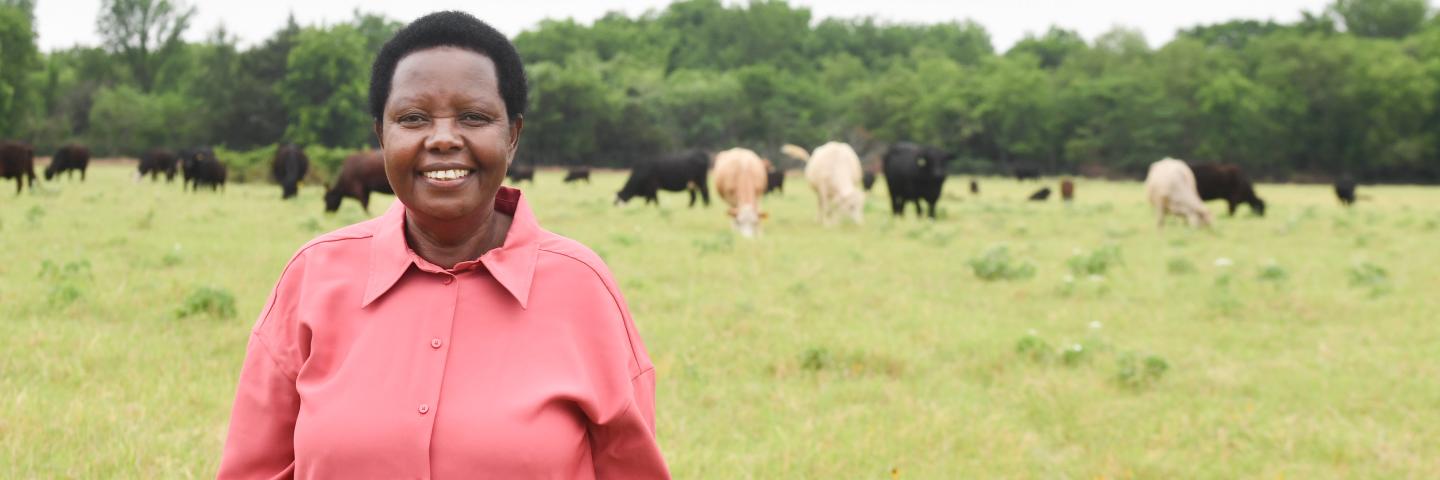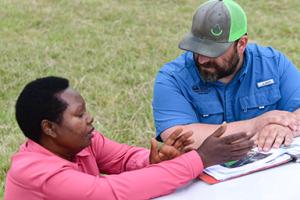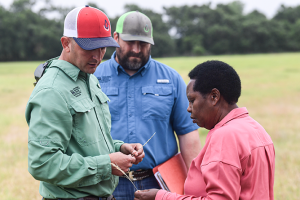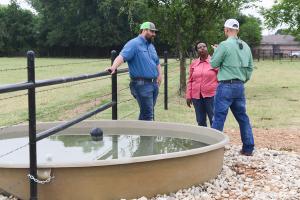A Dream Come True a World Away

Many years ago, and in a land far away from Texas, a young girl lived with her parents on a small farm in Kenya, where they ran a small herd of cattle. Today she is raising cows on her own ranch in McClennon County, Texas.
Many years ago, and in a land far away from Texas, a young girl lived with her parents on a small farm in Kenya, where they ran a small herd of cattle. She was raised taking care of those cows, with the charge of feeding and milking them daily.
“I had strong desire to one day own land and raise cows of my own,” said Elizabeth Thinwa, sharing the seeds of her lifelong dream first in her native Swahili language before carefully and delicately translating each and every word to English.
In 2014, she explains, her dream came true and Thinwa was able to buy 142 acres of land, now known as Beth Ranch in Waco, Texas.
Thinking back to her days on her parent’s farm, Thinwa explains her parents’ cows helped the family economically.
“I liked cattle right from when I was little because they provided money for me to go to school. So, I knew it was a good business,” she said.
It was her experience there and that dream of owning her own land and her own cows that would eventually bring Thinwa from Kenya nearly 9,000 miles across the world to the United Sates.
Welcome to Texas
“I migrated to the United States here in Texas in 1995, and at that time I was working in a formal employment, still pursuing my dream and my desire to one day be able to secure a piece of land for myself and raise cows, especially beef cows.”
Of all of the states, Thinwa said she chose to land in Texas after speaking with the consulate at the American Embassy in Kenya, when he was going for her green card.
“I asked, ‘Which is the best state in America and she said ‘Texas’, in terms of economic growth, and the climate was reasonable,” said Thinwa. “I felt it was the place I needed to come, and I cannot regret that—I had arrived here in Texas, and I live in Texas. It was the place I needed to come.”
When Thinwa was finally able to purchase Beth Ranch 19 years later, she felt like she was on track to making her dreams come true; however, she found herself feeling uncertain as to how to get started.
“In Kenya, the experience I had was so limited,” she said. She was aware that there was still so much to learn, and that she needed some direction on what to learn and how to get started.
It wasn’t until Thinwa sought information through the local McLennan County Extension Office that she gained a sense of what direction to take. She was referred to the USDA Natural Resources Conservation Service (NRCS) whom she was told would come out to help her implement a conservation program to improve the ranch and her herd. Of the 142 acres on Beth Ranch, 136 acres are being used for the operation of raising beef cattle. NRCS would provide guidance on how to manage that plot of land, and in turn, raise healthy cattle.
In addition to working with NRCS, Thinwa said she gathered information wherever she could, networking with other ranchers, attending classes through Texas A&M, and frequenting courses through the McLennan County Extension Office. Any additional source of information was another opportunity for her to improve upon her operation.
Living the Dream—So Far
In a scene right out of a movie, Thinwa calls out to her cows in a language they seem to understand, as they quickly respond by joining her on a walk across a grassy pasture, trusting and willing to follow her lead. She describes the exchange as something she loves.
“You see how I was talking with the cows? I come here and interact with the cows. There’s no stress when you are dealing with the cows, so I like that,” she said, smiling.
And running the operation itself?
The business with the cows is worth it, according to Thinwa. While her husband enjoys coming to the ranch occasionally, Thinwa is the primary operator.
“I have loved it,” said Thinwa. “I had to quit my job when I started establishing this ranch. I quit my job to put all my effort into working on this ranch and I cannot really regret it because I have seen the payoffs in terms of finances, and in the form of enjoyment that the people who come here derive from it, and from the people who have come here and want to go and improve their properties.”
Just as she started by receiving help from helpful neighbors, the NRCS and other great resources, Thinwa now gets to provide that same guidance and support to others.
“So that is what I have really achieved so far.”
Conserving the Land
Thinwa’s property sits just a few miles from Interstate 35, Texas’ biggest and busiest roadway. As a landowner in one of the fastest developing areas in Texas, she understands and values the concept of natural resource conservation, not just for the land or the animals, but for the people, too.
“It’s very important to conserve this,” she said, looking around at the beautiful landscape of Beth Ranch. She pointed to a watershed where she said animals like to frequent, including deer, many different birds, and even coyotes which she said she can sometimes hear at night.
Thinwa and her family, her husband, Wominar, their two daughters and two grandchildren, live in Houston and Dallas.
“My grandkids had never heard coyotes. They’d never seen a deer. When they come here, they see a deer,” she said. “It’s life.”
“Life is not just seeing the buildings,” said Thinwa. “This is what life is all about.”
Thinwa’s words are heartfelt and it’s clear she hopes to pass on the things she holds so dear—the things she discovered for herself in a faraway place as a child.
“They’ll know where you get meat from,” she said. “They’ll know what it takes to make your hands dirty and what are the benefits of doing that.”
She has certainly rolled up her sleeves and gotten her hands dirty, especially since she began working with the NRCS.
“They came out here and they advised me because of the mesquites,” she said. She was told she needed brush and grass management, as well as a new water system to be set in place for her cattle.

She recalls meeting with NRCS District Conservationist Clete Vanderburg for the first time, whom she describes as being very eager to provide technical assistance, as well as help build her a conservation plan. He went through the different conservation practices, identifying the Environmental Quality Incentives Program (EQIP) as an appropriate program for her land. They met at Beth Ranch and talked through what needed to be done, and he designed a plan for Thinwa in terms of brush management to improve the grass as well as to improve her water system to make it more efficient. Cross fending also came up, so Thinwa could improve her pastures for rotation.
“It’s been a lot of fun to get to know her as a person and to see her love for animals, for land. Not only for livestock but for wildlife, and just caring for what she has on her own property,” said Vanderburg.
“She stuck to a plan and with her dream of owning property, she finally has it and wants to take care of it. She wants to manage it to where it’s going to be improved in the future, and she’s been so open to everybody’s advice and she’s seeking the right advice.”
The conservation plan designed by NRCS started with brush management and led to additional practices including grass planting, installing cross fencing to help with rotational grazing, and updating Thinwa’s livestock watering system to include pipeline and strategically placed troughs making the process more efficient and cost-effective
As a result of NRCS’s support, Thinwa’s soil has improved thanks to knowing the best fertilizers and grasses are being planted.

“I am so proud that now I have four pastures, I have water in every pasture, and I know the grasses are going to be healthier than before and my herd health is going to improve because of that effort,” she stated.
“It’s been a pleasure working with Mrs. Thinwa,” said Vanderburg. “We have a lot of fun when I come out here. Someone that is passionate about their operation. Someone that shows people that if you have a dream, you can actually complete it and achieve it.
Country Comparison
There are a lot of differences between how things are done here in the United States vs. Africa. Thinwa explains that in Kenya, it’s mainly small-scale farming, whereas in the United States or Texas in particular, a lot of it is larger scale ranching.
“Ten percent of cattle keeping in Kenya is in ranching, but 90 percent of cattle keeping in Kenya is done by subsistence farming,” she said. Those living in arid areas depend on the rain and move from one place to the other, which means their productivity is limited. The other section, or subsistence farming, is where the majority of the farmers own an average of 1-10 acres. They tend to keep their livestock in a small section of that land and grow their crops in the other area. They bring those resources to the cow, saving their energy from otherwise having to walk and graze the land. The manure is then swept and brought back to the land. Through this system, there is not much waste.
“It’s very labor intensive,” said Thinwa.“Where here in Texas, ranching is the key. It’s not very labor intensive because of mechanization. People have tractors, people can cut hay because there’s a lot of land.”
Kenya also has limited sales mechanisms, like butcher shops or private venues, whereas here we have set up many different platforms through which to sell the meat.
This was yet another area with which she said NRCS helped her to navigate.

“She is a person that is doing this for a living and when you’re doing it for a living you need to become more efficient. And she is becoming more efficient every single year in her operation, and I look forward to seeing what other ideas that we can come up with on this place to help her improve it.”
Sharing Her Dream
“I want to conserve this for my children and my children’s children and even other people,” said Thinwa, looking over her land and all she has accomplished.
Thinwa is happy now to be in a position where she can pass on what she’s learned here on Beth Ranch.
“I have people coming from Huntsville, Texas, who say they are coming as a group next month to see my cows. They are just coming to see what goes on. And I have a story to tell them. That when you dream something, don’t let the dream die. It can still come true.”
She is excited to share with people about NRCS and other available resources. “I’ll tell them of how I started, the help that I’ve gotten from NRCS, and other sources to help me reach where I am.”
She also has plans to bring college students to Beth Ranch in order to do their practical’s, as well as reach out to local middle schools to invite children to come and see what a cow operation looks like.
“Because we want a future generation to carry forward, and not to die with us, it’s important to educate children about how to care for land and animals,” Thinwa emphasized. “We want it to continue on.”
As far as she has travelled in life thanks to some big dreams as a small child, it seems as if Thinwa is just getting started. And like her dreams, the possibilities that lay ahead seem endless.
“Truly, I want to be an inspiration to many people. Not just my family, but to other people out there,” she said. “They’ll be inspired by a little girl dreaming and having the dream come true.”

